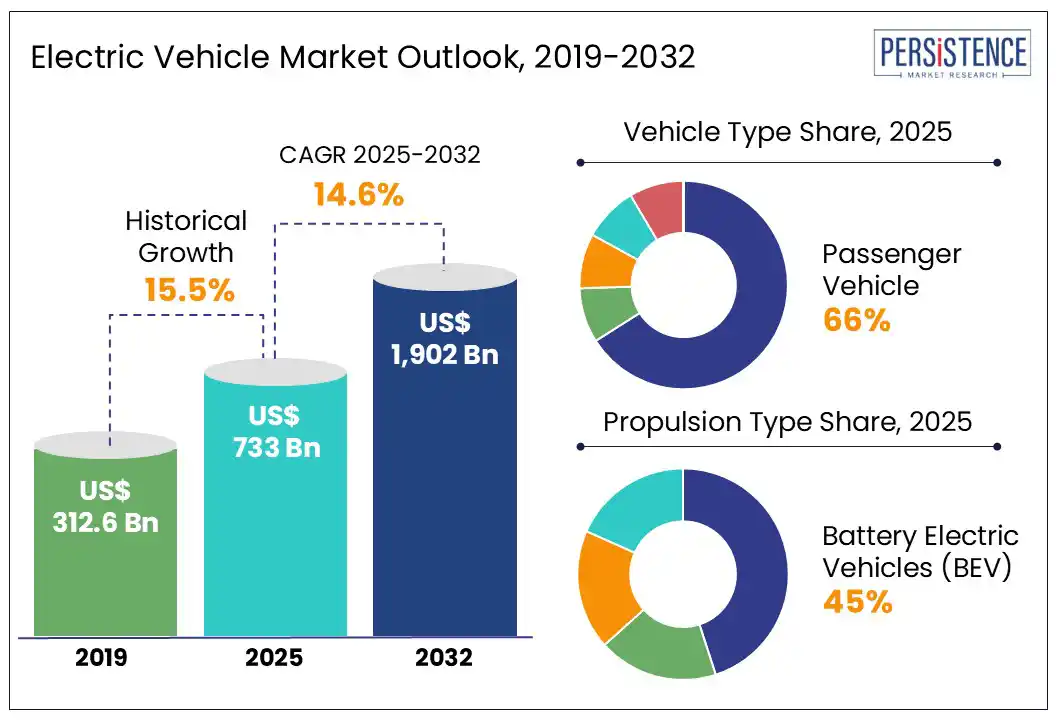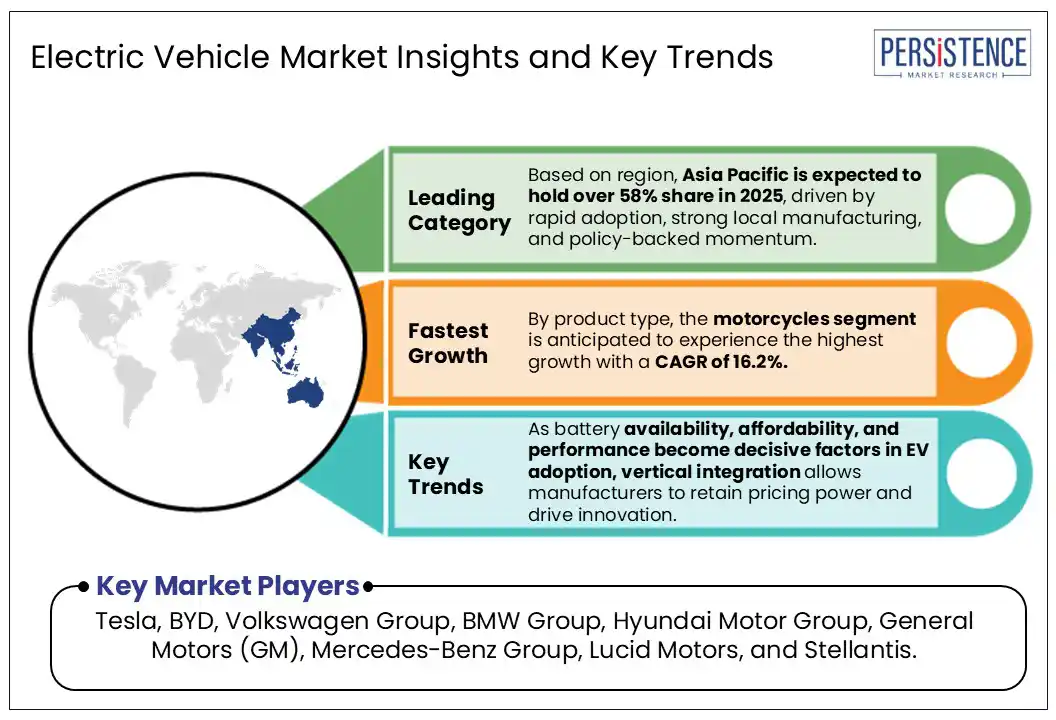ID: PMRREP2843| 189 Pages | 16 Jul 2025 | Format: PDF, Excel, PPT* | Automotive & Transportation

The global electric vehicle market size is likely to be valued at US$ 733 Bn in 2025 and is estimated to reach US$ 1,902.0 Bn in 2032, at a CAGR of 14.6% during the forecast period 2025 - 2032.
The global electric vehicle market growth is primarily driven by advancements in battery technology, cost reductions, and robust tax incentives. While high upfront costs and limited charging infrastructure remain challenges; however, lower operating costs and vertical integration offer competitive advantages. Battery Electric Vehicles (BEVs) are leading the transition, with passenger cars dominating the market share. Asia Pacific, led by China, holds over 58% of global EV sales, followed by a recovering European market with strong policy-driven BEV adoption.

Key Industry Highlights
|
Global Market Attribute |
Key Insights |
|
Electric Vehicle Market Size (2025E) |
US$ 733 Bn |
|
Market Value Forecast (2032F) |
US$ 1,902 Bn |
|
Projected Growth (CAGR 2025 to 2032) |
15.5% |
|
Historical Market Growth (CAGR 2019 to 2024) |
14.6% |
The market is undergoing accelerated transformation, supported by favorable government policies, stringent environmental regulations, and evolving automotive strategies. Targeted fiscal measures such as purchase subsidies, tax exemptions, and direct consumer incentives have significantly lowered the upfront cost of electric light-duty vehicles (LDVs), stimulating mass-market adoption. Early implementations in countries including Norway, the U.S. and China set the foundation for widespread EV acceptance and scaled-up battery and vehicle production.
Simultaneously, over 85% of global vehicle sales are now subject to increasingly stringent fuel economy and CO? emission standards. Regulatory leaders, including the EU, California, and China, have reinforced this shift with mandatory zero-emission vehicle (ZEV) targets, making EV deployment critical for compliance and long-term competitiveness.
Infrastructure development is also gaining momentum, with public investments, private sector collaboration, and regulations such as compulsory EV charging provisions in new buildings to eliminate deployment hurdles. Complementary urban mobility initiatives, such as low-emission zones and preferential access for EVs, are also propelling adoption in densely populated areas.
A major barrier to the adoption of EVs is the underdeveloped charging infrastructure. While consumer interest in EVs is increasing, the lack of widespread, reliable, and high-speed charging options continues to slow market growth. Public charging stations are still limited in availability and convenience, and the existing networks are mainly made up of slow AC chargers (Level 1 and 2) that take hours to charge.
Although DC fast chargers dramatically cut charging time, they require a high upfront investment and a specialized setup. In contrast, internal combustion engine (ICE) vehicles benefit from a broad and efficient refueling network, giving them a clear convenience edge. This leads to a range of anxiety and infrastructure limitations that discourage potential buyers. Without scalable, fast, and affordable charging networks, especially in underserved urban and rural areas, the transition to EVs will stay slow.
The rise of BYD presents a clear opportunity for EV manufacturers to gain significant market share through vertical integration. BYD’s success in delivering over 4.27 million new energy vehicles in 2024 and nearly 1 million units in Q1 2025 demonstrates how full control over the value chain can become a key competitive advantage. By managing everything from raw material procurement and battery production to in-house software development and vehicle assembly, BYD has significantly reduced production costs, minimized supply chain disruptions, and accelerated product development timelines.
For other manufacturers, replicating this model represents a major opportunity to improve cost efficiency, secure critical components, ensure quality control, and respond faster to market demand. As battery availability, affordability, and performance become decisive factors in EV adoption, vertical integration allows manufacturers to retain pricing power and drive innovation, making it a powerful strategy to capture a dominant share in an increasingly competitive market.
BEVs are emerging as the dominant propulsion technology in the market, projected to command approximately 45% of the market share by 2025. With an expected CAGR of 14.3% through the forecast period, BEVs are rapidly outpacing other powertrain technologies. This growth is driven by key advantages such as zero tailpipe emissions, reduced maintenance and operating costs, and expanding government incentives for clean mobility solutions.
The ongoing decline of ICE vehicles reflects a clear industry pivot, with ICE models forecast to represent only a marginal share by 2032. In contrast, hybrid powertrains, particularly PHEVs and Mild Hybrid Electric Vehicles (MHEVs), continue to function as transitional solutions. As BEVs become more affordable and supported by increasingly robust charging infrastructure, the relevance of hybrids is expected to diminish over time.
FCEVs, while still in the early stages of adoption, are gaining traction in niche segments such as heavy-duty and long-haul transport, where hydrogen’s advantages in range and rapid refueling provide unique value.
Industry leaders are accelerating the shift. Tesla currently holds an 18% share of the global BEV market, while BYD has become the world’s top BEV and PHEV manufacturer following its exit from ICE-only vehicle production. In 2023, BYD sold over 3 million EVs, highlighting the scale and momentum behind the electrification wave.
The passenger car segment is projected to lead the market in 2025, capturing a dominant share of over 66%, reflecting its central role in the global shift toward electrified private mobility. According to industry analysis, this segment is expected to maintain robust expansion, registering a CAGR of 13.9% through 2032.
The electric passenger car segment encompasses BEVs, PHEVs, and extended-range electric vehicles (EREVs). BEVs are witnessing the highest adoption, driven by advancements in battery technology, declining production costs, and expanding charging infrastructure. BEVs operate solely on electricity and are equipped with high-capacity lithium-ion batteries, offering zero tailpipe emissions and reduced operating costs compared to internal combustion engine vehicles.
China is projected to sell approximately 10 million electric passenger cars in 2024, representing around 45% of its total car sales. The U.S. is forecasted to reach nearly 11% EV penetration in new car sales, while Europe is expected to account for about 25% of total passenger car sales through EVs, despite facing regulatory and subsidy-related headwinds in select regions.
Rising raw material costs, supply chain disruptions, and regional disparities in charging infrastructure development pose significant hurdles. As government incentives phase out and competition intensifies, automakers must innovate continuously to maintain market momentum and consumer interest.

The Asia Pacific region will continue to lead the global market, holding over 58% of the total market share in 2025, fueled by strong manufacturing capacity, rapid EV adoption, and supportive policy frameworks. China leads the charge; in 2024, China alone sold more than 11 million EVs, exceeding the entire world’s EV sales in 2022.
Since July 2024, EVs have consistently outsold ICE vehicles monthly, and by the end of the year, nearly half of all new vehicle sales were electric. The shift is being propelled by improving cost parity with ICE models, changing consumer preferences, and impactful incentives. A state-backed trade-in initiative launched in April 2024 drew 6.6 million applicants, of which 60% opted for EVs, underlining the role of strategic policy in accelerating adoption.
India is building its EV foundation, recording nearly 50% growth in EV sales in 2023, surpassing 1.5 million units. The market is preparing for the launch of premium EVs throughout 2025, supported by a rapidly developing battery manufacturing sector. A national EV penetration target of 30% by 2030 is guiding both private and public sector investments.
Japan and South Korea are focusing on localization and innovation. Toyota is investing US$2 billion to set up a Lexus EV plant in Shanghai and collaborating with Huawei on new electric models. Nissan is planning to launch ten EVs in China by 2027, including an electric pickup tailored to local needs. Hyundai is also expanding its China-specific EV strategy, launching the Elexio model and preparing a broader electric and hybrid lineup by 2027.
Europe remains the second-largest market globally and is poised for robust growth. Between January and April 2025, over 2.2 million EVs, including BEVs, PHEVs, and HEVs, were registered across the EU, with Norway, Switzerland, and Iceland, marking a 20% year-over-year increase. BEVs saw particularly strong momentum, with registrations up by 26%.
In April 2025, BEVs and PHEVs together accounted for 26% of total new car registrations. BEVs alone captured 17% market share, up from 13.4% in April 2024, while PHEVs rose to 9% from 6.9% during the same period. The growth is driven by the accelerating presence of Chinese EV brands across Europe. France and the U.K. reported around 15% growth, with BEVs outperforming PHEVs.
Conversely, Germany experienced a nearly 5% drop in EV sales due to the discontinuation of subsidies in 2023. Italy witnessed a more significant contraction of over 20% in the first quarter, particularly in the PHEV segment, though upcoming launches from brands such as Chery and new government incentives may stabilize the market. The adoption of e-bikes is gaining traction, with subsidies in several countries offering rebates of up to 50% on lower-powered models further advancing Europe’s clean mobility agenda.
The global electric vehicle market is undergoing intense transformation, shaped by aggressive pricing, rapid technological advancements, and expansive global strategies. Asia Pacific, led by China and followed by India and Southeast Asia, will remain the primary growth engine for global EV adoption.
In China, Tesla triggered a price war with discounts of up to CNY 15,000 (US$ 2,092.47), prompting competitors such as BYD, XPeng, and GM-SAIC-Wuling to follow suit. Chinese EV manufacturers now outpace global rivals in product integration, technology, and supply chain efficiency.
In the U.S., Tesla’s market share declined from 60% in 2020 to 45% in 2023. Its future growth hinges on successful execution in autonomous driving and robotics. Meanwhile, Hyundai-Kia captured 8% market share by leveraging IRA incentives and local manufacturing.
Europe’s market remains resilient but fragmented due to inconsistent national policies and subsidy rollbacks. Plug-in hybrids offer short-term gains but lack long-term momentum compared to fully electric models. Legacy automakers’ market share dropped from 80% in 2015 to 60% in 2023, with Chinese brands and Tesla gaining ground. Price sensitivity, slow charging infrastructure expansion, especially in rural areas, and shifting consumer trust based on brand values and ethics are influencing purchase decisions.
The electric vehicle market is estimated to be valued at US$ 733 Bn in 2025.
Strategic policy interventions and industry realignment, and low operating cost accelerates EV adoption, are the key demand driver for the Electric Vehicle market.
In 2025, Asia Pacific is likely to dominate with over 58% share in the Electric Vehicle market.
Among propulsion types, preference for Fuel Cell Electric Vehicle (FCEV)segment is expected to grow rapidly at 19.1% CAGR from 2025-2032.
Tesla, BYD, Volkswagen Group, BMW Group, Hyundai Motor Group, General Motors (GM), Mercedes-Benz Group, Lucid Motors, and Stellantis are some key industry players in the Electric Vehicle market.
|
Report Attribute |
Details |
|
Historical Data/Actuals |
2019 - 2024 |
|
Forecast Period |
2025 - 2032 |
|
Market Analysis Units |
Value: US$ Bn |
|
Geographical Coverage |
|
|
Segmental Coverage |
|
|
Competitive Analysis |
|
|
Report Highlights |
|
|
Customization and Pricing |
Available upon request |
By Vehicle Type
By Propulsion Type
By Range
By Region
Delivery Timelines
For more information on this report and its delivery timelines please get in touch with our sales team.
About Author